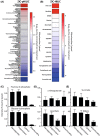Rapid fractionation of mitochondria from mouse liver and heart reveals in vivo metabolite compartmentation
- PMID: 36217875
- PMCID: PMC7614208
- DOI: 10.1002/1873-3468.14511
Rapid fractionation of mitochondria from mouse liver and heart reveals in vivo metabolite compartmentation
Abstract
The compartmentation and distribution of metabolites between mitochondria and the rest of the cell is a key parameter of cell signalling and pathology. Here, we have developed a rapid fractionation procedure that enables us to take mouse heart and liver from in vivo and within ~ 30 s stabilise the distribution of metabolites between mitochondria and the cytosol by rapid cooling, homogenisation and dilution. This is followed by centrifugation of mitochondria through an oil layer to separate mitochondrial and cytosolic fractions for subsequent metabolic analysis. Using this procedure revealed the in vivo compartmentation of mitochondrial metabolites and will enable the assessment of the distribution of metabolites between the cytosol and mitochondria during a range of situations in vivo.
Keywords: in vivo; compartmentation; ischemia; metabolites; mitochondria; rapid fractionation.
© 2022 The Authors. FEBS Letters published by John Wiley & Sons Ltd on behalf of Federation of European Biochemical Societies.
Figures








Similar articles
-
Subcellular distribution of lead in cultured rat hepatocytes.Environ Res. 1984 Oct;35(1):188-96. doi: 10.1016/0013-9351(84)90126-9. Environ Res. 1984. PMID: 6489287
-
Effect of glucagon on metabolite compartmentation in isolated rat liver cells during gluconeogenesis from lactate.Biochem J. 1977 Aug 15;166(2):225-35. doi: 10.1042/bj1660225. Biochem J. 1977. PMID: 199159 Free PMC article.
-
Compartmentation of high-energy phosphates in resting and beating heart cells.Biochim Biophys Acta. 1986 Sep 10;851(2):249-56. doi: 10.1016/0005-2728(86)90132-5. Biochim Biophys Acta. 1986. PMID: 3488761
-
Mitochondrial metabolite carrier proteins: purification, reconstitution, and transport studies.Methods Enzymol. 1995;260:349-69. doi: 10.1016/0076-6879(95)60150-3. Methods Enzymol. 1995. PMID: 8592459 No abstract available.
-
Function of the mitochondrial outer membrane as a diffusion barrier in health and diseases.Biochem Soc Trans. 2000 Feb;28(2):164-9. doi: 10.1042/bst0280164. Biochem Soc Trans. 2000. PMID: 10816120 Review.
Cited by
-
Metabolic sensing and control in mitochondria.Mol Cell. 2023 Mar 16;83(6):877-889. doi: 10.1016/j.molcel.2023.02.016. Mol Cell. 2023. PMID: 36931256 Free PMC article. Review.
References
MeSH terms
Grants and funding
LinkOut - more resources
Full Text Sources

